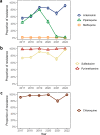Genetic surveillance of Plasmodium falciparum populations following treatment policy revisions in the Greater Mekong Subregion
- PMID: 40394107
- PMCID: PMC12092748
- DOI: 10.1038/s41467-025-59946-1
Genetic surveillance of Plasmodium falciparum populations following treatment policy revisions in the Greater Mekong Subregion
Abstract
Genetic surveillance of Plasmodium falciparum (Pf) can track antimalarial-resistant strains, to inform decision-making by National Malaria Control Programmes (NMCPs). The GenRe-Mekong project prospectively collected 5982 samples in the Greater Mekong Subregion (GMS) between 2017 and 2022, genotyping drug resistance markers, and barcodes that recapitulate genetic variation. Genotypes were analyzed with the grcMalaria R package, first described in this paper, to translate genetic epidemiology data into actionable visual information. Since 2020, Pf incidences decreased rapidly, accompanied by a decline of dihydroartemisinin-piperaquine (DHA-PPQ) resistant lineages, previously dominant in the eastern GMS. The frequency of plasmepsin2/3 amplifications, conferring piperaquine resistance, dropped from 62% in 2017-2019 to 2% in 2022, coinciding with a switch in frontline therapy in Cambodia, Thailand, and Vietnam. While regional artemisinin resistance levels remained high, no evidence of emerging mefloquine resistance was found. Routine genetic surveillance proved valuable in monitoring rapid parasite population changes in response to public health interventions, providing actionable information for NMCPs.
© 2025. The Author(s).
Conflict of interest statement
Competing interests: The authors declare no competing interests.
Figures






References
-
- World Health Organization. World Malaria Report 2022. https://www.who.int/teams/global-malaria-programme/reports/world-malaria... (2022).
-
- Denis, M. B. et al. Efficacy of artemether-lumefantrine for the treatment of uncomplicated falciparum malaria in northwest Cambodia. Trop. Med. Int. Health11, 1800–1807 (2006). - PubMed
-
- Denis, M. B. et al. Surveillance of the efficacy of artesunate and mefloquine combination for the treatment of uncomplicated falciparum malaria in Cambodia. Trop. Med. Int. Health11, 1360–1366 (2006). - PubMed
MeSH terms
Substances
Grants and funding
LinkOut - more resources
Full Text Sources

